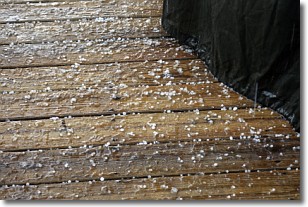Weather Alert in Louisiana
Flood Warning issued May 11 at 8:50PM CDT until May 29 at 7:00AM CDT by NWS New Orleans LA
AREAS AFFECTED: East Baton Rouge, LA; West Baton Rouge, LA
DESCRIPTION: ...The Flood Warning continues for the following rivers in Louisiana...Mississippi... Tangipahoa River Near Robert affecting Tangipahoa Parish. Mississippi River At Donaldsonville affecting Ascension Parish. Mississippi River At Baton Rouge affecting West Baton Rouge and East Baton Rouge Parishes. Mississippi River At Red River Landing affecting West Feliciana, Pointe Coupee and East Baton Rouge Parishes. Pearl River Near Pearl River affecting Pearl River, St. Tammany and Hancock Counties. Pearl River Near Bogalusa affecting Pearl River and Washington Counties. ...The Flood Warning is extended for the following rivers in Louisiana... Bogue Chitto River Near Bush affecting St. Tammany Parish. For the Lower Mississippi River...including Red River Landing, Baton Rouge, Donaldsonville...Minor to Moderate flooding is forecast. For the Bogue Chitto River...including Bush...Minor flooding is forecast. For the Lower Pearl River...including Bogalusa, Pearl River...Minor flooding is forecast. * WHAT...Moderate flooding is occurring and moderate flooding is forecast. * WHERE...Mississippi River at Baton Rouge. * WHEN...Until Thursday, May 29. * IMPACTS...At 38.0 feet, River traffic and industrial activity on the river side of the levees will be greatly affected. Navigational safety regulations will be strictly enforced. * ADDITIONAL DETAILS... - At 7:00 PM CDT Sunday the stage was 38.8 feet. - Bankfull stage is 29.0 feet. - Forecast...The river is expected to fall below flood stage Thursday, May 29 and continue falling to 30.4 feet Sunday, June 08. - Flood stage is 35.0 feet. - http://www.weather.gov/safety/flood
INSTRUCTION: Turn around, don't drown when encountering flooded roads. Most flood deaths occur in vehicles. Motorists should not attempt to drive around barricades or drive cars through flooded areas. Caution is urged when walking near riverbanks. Additional information is available at www.weather.gov/lix. Click on the Rivers and Lakes menu for forecasts and observations. The next statement will be issued late tonight at 345 AM CDT.
Want more detail? Get the Complete 7 Day and Night Detailed Forecast!
Current U.S. National Radar--Current
The Current National Weather Radar is shown below with a UTC Time (subtract 5 hours from UTC to get Eastern Time).

National Weather Forecast--Current
The Current National Weather Forecast and National Weather Map are shown below.

National Weather Forecast for Tomorrow
Tomorrow National Weather Forecast and Tomorrow National Weather Map are show below.

North America Water Vapor (Moisture)
This map shows recent moisture content over North America. Bright and colored areas show high moisture (ie, clouds); brown indicates very little moisture present; black indicates no moisture.

Weather Topic: What is Rain?
Home - Education - Precipitation - Rain
 Next Topic: Shelf Clouds
Next Topic: Shelf Clouds
Precipitation in the form of water droplets is called rain.
Rain generally has a tendency to fall with less intensity over a greater period
of time, and when rainfall is more severe it is usually less sustained.
Rain is the most common form of precipitation and happens with greater frequency
depending on the season and regional influences. Cities have been shown to have
an observable effect on rainfall, due to an effect called the urban heat island.
Compared to upwind, monthly rainfall between twenty and forty miles downwind of
cities is 30% greater.
Next Topic: Shelf Clouds
Weather Topic: What is Sleet?
Home - Education - Precipitation - Sleet
 Next Topic: Snow
Next Topic: Snow
Sleet is a form of precipitation in which small ice pellets are the primary
components. These ice pellets are smaller and more translucent than hailstones,
and harder than graupel. Sleet is caused by specific atmospheric conditions and
therefore typically doesn't last for extended periods of time.
The condition which leads to sleet formation requires a warmer body of air to be
wedged in between two sub-freezing bodies of air. When snow falls through a warmer
layer of air it melts, and as it falls through the next sub-freezing body of air
it freezes again, forming ice pellets known as sleet. In some cases, water
droplets don't have time to freeze before reaching the surface and the result is
freezing rain.
Next Topic: Snow
Current conditions powered by WeatherAPI.com




